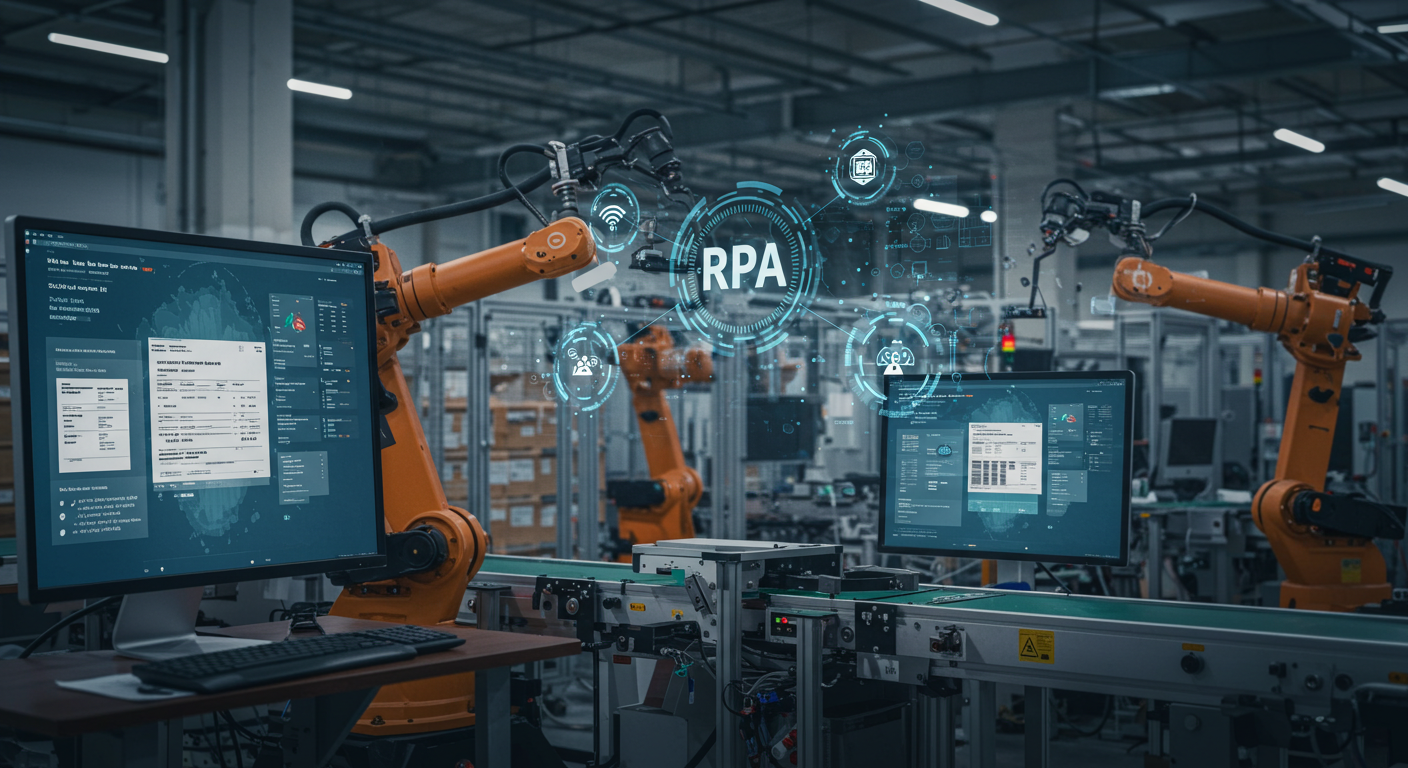Not Just Robots: Why RPA in Manufacturing Is the Key to Future-Proofing Your Business
Picture this: while factory floors buzz with robotic arms assembling products, back offices drown in paperwork. Manual data entry. Invoice processing nightmares. Supply chain chaos. This disconnect explains why 35% of manufacturing companies already lead RPA adoption across industries. But here’s what’s surprising—most manufacturers still haven’t realized RPA’s full potential.
Why does this matter? Manufacturing executives lose millions annually to administrative bottlenecks. Human errors cascade through production schedules. Compliance violations trigger costly shutdowns. RPA in manufacturing solves these problems by automating the invisible processes that keep factories running.
The numbers tell an incredible story. Gartner predicts 90% of large organizations globally will have adopted RPA in some form by 2022. Meanwhile, Forrester forecasts the RPA market will grow to $22 billion by 2025. Manufacturing companies that act now position themselves ahead of competitors still trapped in manual processes.
The Hidden Revolution Behind Factory Walls
When people think of “manufacturing automation,” they visualize robotic arms welding car parts or conveyor belts moving products. That’s only half the story. RPA in manufacturing industry applications works differently—they automate the digital processes that support physical production.
Consider invoice processing. Traditional methods require human workers to open emails, extract data, enter information into ERP systems, cross-reference purchase orders, and route approvals. Each step introduces delays and errors. Software bots complete this entire workflow in seconds. They never take coffee breaks. Never make typos. Never get tired during overtime shifts.
The technology operates through screen scraping, keystroke simulation, and data manipulation. Bots interact with existing software exactly like human users—clicking buttons, filling forms, copying information between applications. This approach requires no expensive system overhauls or lengthy IT projects.
But here’s where it gets interesting: cognitive automation takes RPA further. Modern solutions incorporate machine learning, natural language processing, and computer vision. These smart bots handle unstructured data, make simple decisions, and adapt to process variations. They’re not just following scripts—they’re learning.

Manufacturing's Data Nightmare
Manufacturing generates enormous data volumes. Production metrics, quality measurements, inventory levels, supplier communications, regulatory reports—the list seems endless. Traditional systems create data silos. Information gets trapped in spreadsheets, databases, and legacy applications that don’t communicate effectively.
This fragmentation creates serious problems:
- Decision delays: Managers wait hours or days for consolidated reports
- Inventory mismatches: Production planning uses outdated stock information
- Quality gaps: Defect data doesn’t reach decision-makers quickly enough
- Compliance risks: Audit trails become fragmented across multiple systems
RPA bridges these gaps by automatically moving data between systems, generating real-time reports, and maintaining consistent records. Bots pull information from manufacturing execution systems, update inventory databases, create quality reports, and distribute updates to relevant stakeholders—all without human intervention.
Game-Changing Benefits That Transform Operations
The benefits of RPA in manufacturing extend far beyond simple cost savings, though financial impact remains substantial.
Financial Impact That Matters
Companies investing in RPA experience a 30-50% reduction in operational costs with positive ROI within 12 months. For manufacturing companies, these savings compound across multiple operational areas:
- Labor cost reduction: Software bots cost 1/3 of an offshore employee and 1/5 of an onshore employee. They work 24/7 without overtime pay, health benefits, or training expenses.
- Error elimination: Manual processes generate costly mistakes. Incorrect inventory counts trigger emergency shipments. Data entry errors cause production delays. Quality documentation mistakes result in regulatory violations. Bots eliminate these human-error costs.
- Speed improvements: Capgemini’s internal RPA implementation achieved a 75% reduction in invoice processing time—from 20 to 4 minutes per request. Similar acceleration occurs across manufacturing processes.
Operational Excellence Through Precision
Manufacturing demands precision. Tolerance levels are measured in micrometers. Quality standards that allow zero defects. Production schedules are synchronized across global supply chains. Human limitations create vulnerabilities in these demanding environments.
RPA addresses precision requirements through:
- Consistent execution: Bots follow exact procedures every time. No variation due to fatigue, distraction, or training gaps. Quality control processes maintain identical standards across all shifts and locations.
- Real-time monitoring: Automated systems track key performance indicators continuously. Deviations trigger immediate alerts. Corrective actions begin before problems escalate into major issues.
- Comprehensive documentation: Every bot action gets logged automatically. Audit trails remain complete and tamper-proof. Regulatory compliance becomes demonstrable rather than assumed.
Manufacturing companies report significant quality improvements after RPA implementation. RPA solutions in back-end operations enable enterprises to attain around 40% cost savings in processes ranging from logistics data automation to ERP automation.
Strategic Resource Reallocation
The most transformative benefit involves human capital optimization. Manufacturing workers spend considerable time on repetitive administrative tasks that add little strategic value. RPA liberates these resources for higher-impact activities.
Think about procurement specialists who currently spend hours creating purchase orders manually. With automated PO generation, they can focus on supplier relationship management, cost optimization strategies, and market analysis. Production managers freed from data compilation can concentrate on process improvement initiatives and team development.
This reallocation creates competitive advantages that compound over time. Companies with automation-enabled workforces innovate faster, respond to market changes more effectively, and develop stronger customer relationships.
Real-World Applications That Drive Results
RPA for manufacturing delivers value across diverse operational areas. Here’s where the technology creates the biggest impact:
Supply Chain and Procurement Excellence
Modern manufacturing depends on complex global supply chains involving thousands of suppliers, multiple transportation modes, and intricate logistics coordination. Manual management of these networks creates bottlenecks that ripple through entire production systems.
Automated supplier onboarding streamlines vendor qualification processes. Bots collect documentation, verify certifications, check financial stability, and update approved vendor databases. New supplier activation time drops from weeks to days.
Purchase order automation eliminates manual PO creation delays. Systems monitor inventory levels, identify reorder triggers, select appropriate suppliers based on predefined criteria, and generate purchase orders automatically. Integration with supplier systems enables electronic transmission and acknowledgment.
Supply chain visibility improves through automated tracking updates. Bots query carrier systems, update shipment statuses, identify potential delays, and notify relevant stakeholders. Production planning receives real-time supply information for better decision-making.
Vendor performance monitoring becomes systematic rather than reactive. Automated systems track delivery performance, quality metrics, and cost trends. Monthly supplier scorecards are generated automatically, supporting data-driven vendor management decisions.
Quality Control and Compliance Mastery
Manufacturing quality requirements continue to intensify. Regulatory agencies demand comprehensive documentation. Customers expect zero-defect products. Global markets require compliance with multiple standards simultaneously.
RPA transforms quality management through:
- Automated inspection data collection from various testing equipment
- Real-time defect tracking with immediate alert generation
- Regulatory reporting that stays current with changing requirements
- Audit trail maintenance that supports compliance verification
Bill of Materials (BOM) management exemplifies quality automation benefits. Traditional BOM updates involve manual data entry, version control challenges, and communication delays. Automated systems maintain current specifications, distribute updates instantly, and ensure production uses correct components.
Compliance monitoring becomes proactive rather than reactive. Systems track regulatory changes, assess impact on current processes, update documentation requirements, and alert compliance teams to necessary actions.
Financial Operations Optimization
Manufacturing financial operations involve complex processes spanning multiple departments, currencies, and regulatory requirements. Manual handling creates delays, errors, and audit risks.
Invoice processing automation demonstrates clear RPA value. Bots extract data from supplier invoices using OCR technology, validate information against purchase orders, route approvals based on dollar thresholds, and update accounting systems automatically. Processing time reduced from 20 to 4 minutes per invoice with 91% improvement in accuracy.
Accounts receivable management benefits from automated customer communications, payment processing, and collection activities. Systems generate invoices, send payment reminders, process receipts, and update customer accounts without manual intervention.
Financial reporting automation ensures timely, accurate management information. Bots collect data from multiple sources, apply consistent formatting, generate standard reports, and distribute results to stakeholders according to established schedules.

Production Support That Never Sleeps
Production environments operate continuously. Equipment runs 24/7. Quality monitoring never stops. Maintenance schedules span multiple shifts. Traditional administrative support struggles to match this pace.
Production data management automation ensures continuous information flow. Systems collect machine performance data, update production dashboards, generate shift reports, and alert managers to exceptional conditions. Real-time visibility improves decision-making speed and quality.
Maintenance scheduling becomes predictive rather than reactive. Automated systems track equipment hours, monitor performance trends, schedule preventive maintenance, and order replacement parts proactively. Unplanned downtime decreases significantly.
Inventory management maintains optimal stock levels automatically. Systems monitor usage patterns, predict demand fluctuations, adjust reorder points dynamically, and coordinate with procurement systems for seamless replenishment.
Implementation Strategy That Delivers Success
Successful RPA in manufacturing requires systematic approaches rather than ad hoc implementations. Companies achieve best results through structured methodologies:
Process assessment identifies automation candidates based on:
- High transaction volumes
- Rule-based decision-making
- Minimal exception handling requirements
- Clear input/output specifications
- Stable underlying systems
Pilot project selection focuses on processes offering quick wins and measurable benefits. Early successes build organizational confidence and support for broader automation initiatives.
Change management addresses workforce concerns proactively. Communication emphasizes job enhancement rather than replacement. Training programs help workers develop skills for higher-value activities.
Governance frameworks ensure automation initiatives align with business objectives. Centers of excellence provide standards, best practices, and ongoing support for RPA programs.
Looking ahead, RPA in manufacturing will integrate increasingly with artificial intelligence, machine learning, and cognitive technologies. The worldwide RPA software market grew to $3.2 billion in 2023 with a 22.1% growth rate, indicating continued strong demand for automation solutions.
Manufacturing companies face a clear choice: lead the automation transformation or struggle to compete against more efficient rivals. RPA provides the foundation for operational excellence, cost leadership, and sustainable competitive advantage. The question isn’t whether to implement RPA—it’s how quickly you can capture its benefits before competitors gain insurmountable advantages.